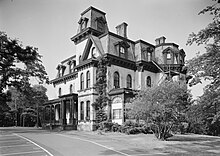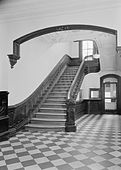
The Cranbrook Educational Community is an education, research, and public museum complex in Bloomfield Hills, Michigan. This National Historic Landmark was founded in the early 20th century by newspaper mogul George Gough Booth. It consists of Cranbrook Schools, Cranbrook Academy of Art, Cranbrook Art Museum, Cranbrook Institute of Science, and Cranbrook House and Gardens. The founders also built Christ Church Cranbrook as a focal point in order to serve the educational complex. However, the church is a separate entity under the Episcopal Diocese of Michigan. The sprawling 319-acre (1,290,000 m2) campus began as a 174-acre (700,000 m2) farm, purchased in 1904. The organization takes its name from Cranbrook, England, the birthplace of the founder's father.

Sterling Memorial Library (SML) is the main library building of the Yale University Library system in New Haven, Connecticut, United States. Opened in 1931, the library was designed by James Gamble Rogers as the centerpiece of Yale's Gothic Revival campus. The library's tower has sixteen levels of bookstacks containing over 4 million volumes. Several special collections—including the university's Manuscripts & Archives—are also housed in the building. It connects via tunnel to the underground Bass Library, which holds an additional 150,000 volumes.

Jonathan Edwards College is a residential college at Yale University. It is named for theologian and minister Jonathan Edwards, a 1720 graduate of Yale College. JE's residential quadrangle was the first to be completed in Yale's residential college system, and was opened to undergraduates in 1933.
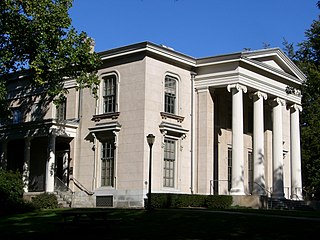
Hillhouse Avenue is a street in New Haven, Connecticut, famous for its many nineteenth century mansions, including the president's house at Yale University. Both Charles Dickens and Mark Twain have described it as "the most beautiful street in America." Much of the avenue is included in the Hillhouse Avenue Historic District, which extends to include houses on adjacent streets.

Delano & Aldrich was an American Beaux-Arts architectural firm based in New York City. Many of its clients were among the wealthiest and most powerful families in the state. Founded in 1903, the firm operated as a partnership until 1935, when Aldrich left for an appointment in Rome. Delano continued in his practice nearly until his death in 1960.

Connecticut Hall is a Georgian building on the Old Campus of Yale University. Completed in 1752, it was originally a student dormitory, a function it retained for 200 years. Part of the first floor became home to the Yale College Dean's Office after 1905, and the full building was converted to departmental offices in the mid-twentieth century. It is currently used by the Department of Philosophy, and its third story contains a room for meetings of the Yale Faculty of Arts & Sciences, the academic faculty of Yale College and the Graduate School.

The Goodall Wooten House is a historic home built in 1898–1900 in Austin, Texas, USA. It was built by local doctor and benefactor Goodall H. Wooten and his wife Ella and was noted for its Classical Revival architecture and lush gardens. The building has served many purposes since passing out of the Wooten family in 1944, such as a student residence hall, a chemical dependency treatment center, a luxury hotel called "The Mansion at Judges' Hill" and currently, a boutique hotel called "Hotel Ella." The structure was added to the National Register of Historic Places on April 3, 1975.

Wilson Eyre Jr. was an American architect, teacher and writer who practiced in the Philadelphia area. He is known for his deliberately informal and welcoming country houses, and for being an innovator in the Shingle Style.

The Henry F. Miller house is an international style house at 30 Derby Avenue in Orange, Connecticut on the United States National Register of Historic Places. The house was designed and built in 1948-1949 by Henry F. Miller as a thesis project for a Master of Architecture at the Yale School of Architecture. The house was one of the areas first modern houses and was featured in the New Haven Register as "The House of Tomorrow". It was open to visitors for a few weeks after completion to raise funds for the New Haven Boy's Club. It was viewed with "wild anticipation," and about 25,000 people paid a small admission to see it. The house was also covered in House Beautiful as part of a series on "The New American Style."
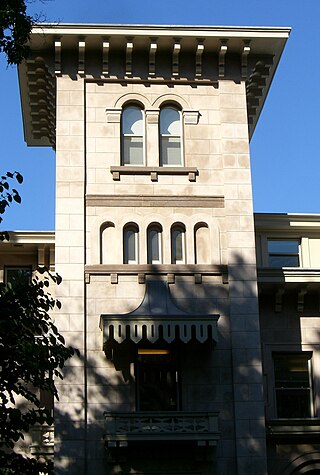
Henry Austin was a prominent and prolific American architect based in New Haven, Connecticut. He practiced for more than fifty years and designed many public buildings and homes primarily in the New Haven area. His most significant years of production seem to be the 1840s and 1850s.

Oldfields, also known as Lilly House and Gardens, is a 26-acre (11 ha) historic estate and house museum at Newfields in Indianapolis, Indiana, United States. The estate, an example of the American country house movement of the late nineteenth and early twentieth centuries, was designated a U.S. National Historic Landmark in 2003.
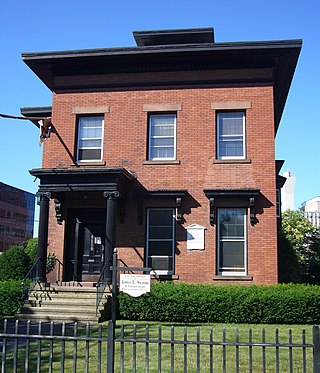
The Lafayette B. Mendel House is an historic Italianate house at 18 Trumbull Street in New Haven, Connecticut. This building, designed by New Haven architect Henry Austin, was the home of Yale University physiology professor, Lafayette Benedict Mendel (1872–1935) from 1900 to 1924. It was declared a National Historic Landmark in 1976 for its association with Mendel, who discovered vitamins A and B, and greatly expanded knowledge of nutrition and food-related biochemistry. The building now houses a law firm.
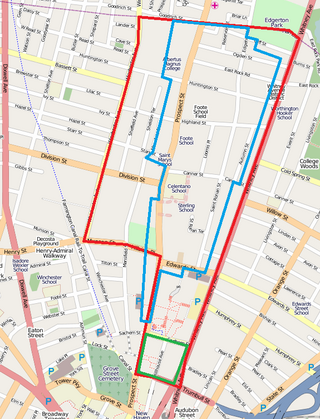
Prospect Hill is a neighborhood of the city of New Haven, Connecticut located in the north central portion of the city, directly north of Downtown New Haven. The neighborhood contains residences, institutional buildings of Albertus Magnus College and a portion of the main campus of Yale University, including the Science Hill area, the Hillhouse Avenue area and the Yale Peabody Museum. The City of New Haven defines the neighborhood to be the region bounded by the town of Hamden in the north, Winchester Avenue in the west, Munson Street/Hillside Place/Prospect Street in the southwest, Trumbull Street in the south, and Whitney Avenue in the east. Prospect Street is the main thoroughfare through the neighborhood.
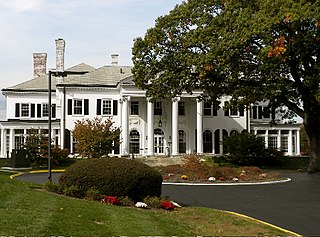
The Prospect Hill Historic District is an irregularly-shaped 185-acre (75 ha) historic district in New Haven, Connecticut. The district encompasses most of the residential portion of the Prospect Hill neighborhood.
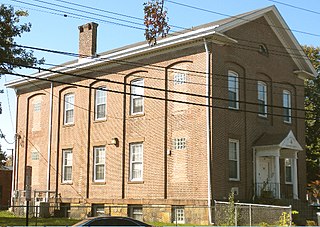
The Goffe Street Special School for Colored Children is an important landmark of African-American history at 106 Goffe Street in New Haven, Connecticut. The building, also known as Prince Hall Grand Lodge of Masons, was added to the National Register of Historic Places in 1979.

Leoni W. Robinson (1851-1923) was a leading architect in New Haven, Connecticut.

Rufus G. Russell (1823-1896) was an architect working from New Haven, Connecticut.

Science Hill is an area of the Yale University campus primarily devoted to physical and biological sciences. It is located in the Prospect Hill neighborhood of New Haven, Connecticut.

The history of the Culinary Institute of America (CIA) began in 1946 in New Haven, Connecticut, where it was founded as a vocational institute for returning veterans of World War II. With a growing student body, the Culinary Institute purchased a former Jesuit novitiate in Hyde Park in 1970, which remains its central campus. The school began awarding associate degrees in 1971 and bachelor's degrees in 1993. The school opened its St. Helena campus in 1995, its Texas campus in 2008, its Singapore campus in 2010, and its Napa campus in 2016.

The President's House at the University of Michigan is the official home of the president of the University of Michigan, located at 815 South University, on the University of Michigan campus, in Ann Arbor, Michigan. The house is the oldest building on the university campus, and is one of the original four houses constructed for faculty when the university moved from Detroit to Ann Arbor. The house was listed on the National Register of Historic Places in 1970.


